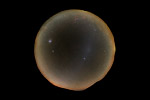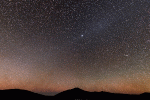 |  |  |  | ||||
I was wondering what conditions should be met to have the "darkest" sky ... Well, obviously there should be no Moon light. The Milky Way and zodiacal light should not be visible neither, and the image should be taken at a place with no light pollution. If these are correct criteriae, the following picture must be very close to what the "darkest" sky could be. The following image was taken at new Moon (No Moon light), middle of the night (minimum zodiacal light effect), in the Atacama desert close to Paranal observatory (no light pollution). The chosen place for this picture has the particularity to be located at a latitude which value is close to the declination of the galactic southern pole. The picture was therefore also taken when the galactic pole passes at zenith, ensuring that there is no Milky Way up in the sky. When all these conditions are met, the very faint Gegenschein becomes visible. Like the zodiacal light, the gegenschein is sunlight reflected by interplanetary dust. Most of this dust is orbiting the sun in about the ecliptic plane. The first image of this kind ever taken was made a few years ago here.. The "by product" of this image is that the Milky Way plane lies all around the horizon as visible in this 360 degrees panoramic view. Zoomable and 'full-screenable' fisheye view of the "darkest" sky image. The Gegenschein is clearly visible covering most of the right side of the picture. The Large (LMC) and Small (SMC) Magellanic clouds are visible to the left, Orion constellation with Barnard loop to the top, California Nebula and 'tiny' Andromeda galaxy to the right while the Milky Way is visible all around the image on the horizon line. Bright jupiter is visible near the center of the image and bright red Eta Carina Nebula is rising on the horizon line at the very left. here: http://www.eso.org/~sguisard/Pagim/darkest_sky.html#Picture1 | |||||||
Monday, November 01, 2010
The darkest sky ? Milky Way all around the horizon line and Gegenschein. © Stéphane Guisard, Los Cielos de Chile
Subscribe to:
Post Comments (Atom)
No comments:
Post a Comment